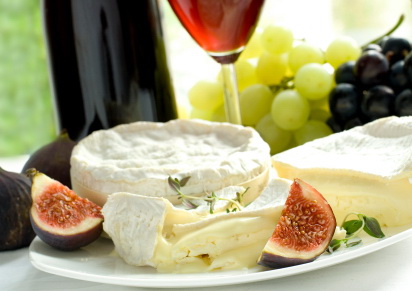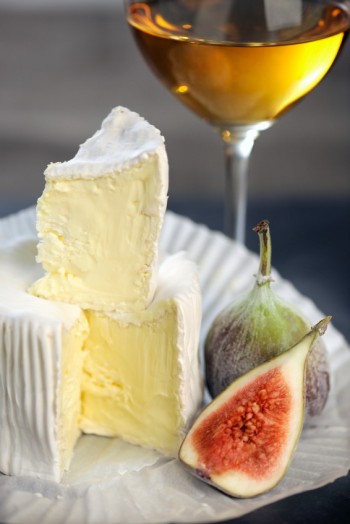It’s been said that wine and cheese are not only the perfect marriage, but the one that never breaks up! The key here is to build up a momentum. Offering three separate servings, start with lighter cheeses accompanied by light wines or beers and move on to stronger cheeses and more full-bodied vintages. And don’t forget to look for the 100% Canadian milk symbol whenever you buy cheese.
Presentation:
It doesn’t take much to attract a crowd to cheese. So a simple, elegant plate can suffice. But a lovely assortment of cheeses luxuriously laid out on a prized marble or porcelain platter is pure art. And feel free to get experimental. A wicker tray, an unusual piece of wood or an old mirror. Cheese works with every style from classically formal to pure bohemian.
You may even want to go as far as naming your choices. Sliced figs, uncracked walnut shells, event bottle corks make nifty label holders.
Breads & Crackers:
There are as many breads as there are Cheeses. So you may want to play it simple with a crusty baguette, or vary your breads along a scale as you do your Cheeses. Raisin, nut bread, sourdough, pumpernickel… Just remember the idea is not to overwhelm the taste of the Cheese.
You also want to combine breads according to textures. So a dark rye works well with a Havarti, a nut bread with a blue Cheese. And be careful with biscuits and crackers; mild to neutral are best. You don’t want an overly salty taste competing with your Cheese.
Serving Temperature:
It is always recommended to bring Cheeses to room temperature by taking them out of the refrigerator 45 minutes to an hour in advance (but not more). You don’t want your Cheese getting runny. If you prepare a plate or a Cheese board beforehand, make sure to cover it with a plastic wrap or a moist tea towel to prevent Cheeses from drying out or absorbing other aromas.
Cheese Tasting:
Leave rinds on to keep Cheeses from drying out. Except for waxed rind Cheese, all rinds are edible and part of the cheese-savouring experience!
Fresh Cheese are not recommended for a tasting, but if served, should not be heavily flavoured with herbs and spices as they interfere with the subtleties of other Cheeses and wines.
Distance Cheeses carefully so they do not touch each other. You do not want to mix flavours.
Provide a different knife for each Cheese.
Start by smelling the cheeses to detect the differences in aroma.
Feel and taste the curd without the rind, taste them separately, then together.
Organizing a Cheese Tasting:
Here is the amount of cheese to buy depending on the occasion. We suggest 3 traditional courses to organize a wine and cheese tasting. We usually start with cheeses that are mild and move to stronger ones.
To serve as an aperitif or at the end of a meal: 45 to 60 grams per person
To serve at happy hour: 90 to 150 grams per person
To serve as a more substantial tasting: 250 grams per person
Here is a practical formula to help you figure out how many grams you need to buy per cheese:
(Pers. × Qty) ÷ (cheese × Course) = Quantity per cheese
Pers. = number of people
Qty = recommended quantity per person
Cheese = number of cheeses
Course = number of courses
Storage – Here are some ideas to keep cheeses fresh longer.
In the Fridge:
As a rule, make sure that the wrapping adheres well to the cheese to avoid dry out.
Store your cheeses in the lower shelf of your refrigerator, far from foods with strong odours, to avoid absorption of unwanted tastes and smells. If you follow these rules, your refrigerator’s vegetable drawer will make a good storage place.
To preserve its freshness, plastic wrap is the most versatile and accessible.
It also provides the tightest seal to protect it from moisture, odours and possibly mould in the fridge.
Store Canadian Bocconcini and Feta in the brine it was sold in, or in lightly salted water. Be sure to always respect the “best before” date.
Light:
Canadian light cheeses have higher moisture content. And since micro-organisms need moisture to breed, this means that light cheeses have a shorter shelf life. How much shorter? That depends on the cheese. However, do check “best before” on the packaging and monitor light cheeses more closely.
Fresh:
Shelf life of Fresh cheeses is the shortest of all cheese categories: A few days to a couple of weeks according to the cheese. So put your trust in the “best before” label on the package.
Soft:
Soft cheeses are at their best when they emit an aroma of mushrooms and the rind supple when pressed slightly under your finger. A very strong smell or an ammonia-like odour is a sign that the cheese is overripe.
Firm:
Firm cheeses keep very well, from a few weeks to several months. In fact, cheeses continue to ripen and to develop the different tastes.
Hard:
Stored properly, Hard cheeses can keep for up to a year. Just make sure to change the wrapping regularly because these cheeses can absorb the strong odours of certain vegetables.
Shelf life after opening – Those timelines are guidelines so keep in mind to respect the “best before” date.
Fresh cheese: a few days to 2 weeks or more
Soft cheese: 2weeks in plastic wrap
Semi-soft cheese: 2-4 weeks
Firm cheese: 5 weeks to a few months
Hard cheese: over one year
What to do about mould:
Sometimes little whitish spots appear on the cheese, signalling the onset of mould. If the cheese is firm, semi-soft or hard, you can eat the cheese anyway, as long as you cut away the affected part. Remove at least ¼” of the mouldy cheese and wrap this up in plastic before putting it in the garbage. Wrap the rest in plastic wrap. However, if the rind is dry and yellowed and smells like ammonia, the cheese should be discarded. Any soft or fresh cheese that shows signs of mould should be thrown out.
In the Freezer:
You can freeze many Canadian cheeses, in pieces of 500 g or less, for up to two months! The most freezer-friendly are those in the semi-soft, firm and hard categories. Simply use thick freezer bags to protect against exposure to air, and defrost in the fridge rather than at room temperature.
Do keep in mind that freezing can affect their texture and character. This is why thawed cheeses are best used for cooking.
Soft (Brie, Camembert, etc.) and fresh cheeses (Cottage, Cream, Quark, Ricotta, etc.) are not recommended for freezing, so enjoy them while they’re fresh!
Left-over:
Left-over cheese will retain its flavour and moistness if you re-wrap it in the original wrapping and refrigerate as soon as possible. If it does appear to be past its prime, however, here’s a rescue plan:
Grate or melt hardened cheeses into your favourite recipes or fondue. Shavings of Canadian Cheddar can liven up a tomato or onion soup, and left-over Brie is ideal in an omelet. Or give Brick cheese a second life by shredding it on pizza.
Cutting the cheese – A cut above:
To enjoy cheese, you have to know how to cut it. The idea is to allow each guest to fully experience a cheese, from its interior to its rind. When serving a washed or bloomy rind cheese, make sure you cut the cheese so that your guests have some of the rind on the curd to experience the true flavour and texture of the cheese
Tips: to help cut your cheese hold the blade of your knife under hot water, dry it and then cut your cheese. It cuts like butter!
Kitchen Technique – How to shred cheese:
Packages of grated cheese are very practical, but if you do it yourself you can choose the thickness of the shredding. Plus, you can create your own mixes. For best results, make sure the cheese is well chilled before shredding. Leftovers will keep in the fridge for about eight days in an airtight container. You can also freeze them if you use a freezer bag and squeeze out as much air as possible.
Snack Ideas:
Sprinkle your spinach with grated parmesan Make a quick dip for your raw vegetables. In a blender, combine cream cheese, plain yogourt and tomato paste to the desired consistency.
Snack on fruit and firm cheese. Spear apple wedges and cubes of Oka, Saint-Paulin, Gouda or Colby with toothpicks.
Fill celery stalks with cream cheese.
Bacon bite: Brush tortillas with thick salsa, cover half of each tortilla with 3 slices of crispy bacon and top with shredded Canadian Monterey Jack with jalapeno. Roll up and refrigerate. When ready to serve, bake at 375 F for about 10 minutes. Slice each tortilla about 10 pieces and arrange on serving platters.
Tiny Cheese Kebabs: Skewer cubes of firm Canadian cheese, alternating with grapes or lemon-juice-dipped apple wedges. Refrigerate.
Cheese Popcorn: Toss hot popcorn with butter, salt and grated Canadian Parmesan. Add chili powder for a festive-looking kick.









